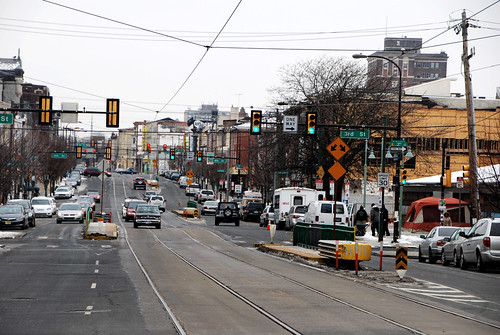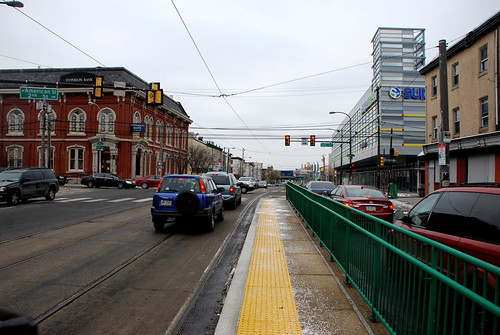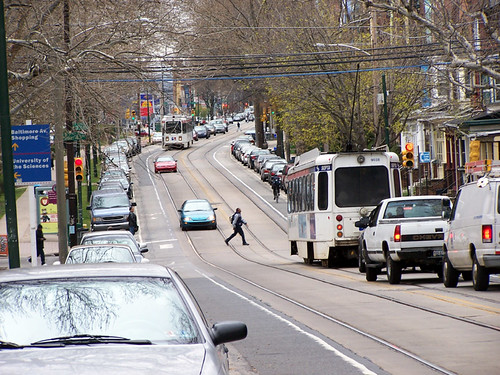As Denver considers the possibility of streetcars on Colfax, it may be informative to learn about what other cities have accomplished.
Philadelphia’s streetcar network is one of the largest and busiest in the United States. It’s vintage, dating to the original trolley era. While Philadelphia did follow the national 20th Century trend of ripping out many of its historic streetcar lines, they also kept many.
Philadelphia’s Girard Avenue trolley, with island platform.
The Girard Avenue line pictured above even uses vintage trolley vehicles, originally built in 1947, and still running today. It also runs in a unique track arrangement, with tracks down the center of wide Girard Avenue, and stations in narrow floating medians.
The Girard Avenue trolley’s floating platforms.
The Girard Avenue arrangement is atypical. Even on lines that run in mixed-traffic with cars, most contemporary streetcars either run curbside or in tracks adjacent to a full median.
Philadelphia’s center-running tracks result in fewer conflicts with parked or turning cars, which speeds the trolleys down their route. It’s almost-but-not-quite like a dedicated transitway.
Unfortunately, the platforms are too narrow to meet modern disability-accessible design guidelines. If Denver were to use a similar arrangement, we’d need wider platforms and thus more street width.
Narrow platform on the Girard Avenue trolley line.
On narrower streets in West Philadelphia, trolleys still run in the center, with bike lanes between the tracks and a row of parked cars.
West Philadelphia trolley line.
The trolley subway
Five trolley routes that run on-street in West Philadelphia combine and then move into a dedicated trolley subway to speed through Center City. It’s a great way to maximize the efficiency of the system through its most dense and congested section, while still taking advantage of the flexibility of on-street operations further out.
13th Street trolley subway station.
Any potential Denver streetcar plan will probably not have tunnels. They’re hugely expensive, after all. But maybe someday.
In future posts, we’ll look at streetcars in other cities around North America.















I was in CC this past weekend and couldn’t even find parking in a garage it was so busy. While I agree a street car on Colfax (Ideally from Civic Center Park station to the I225 light rail line in Aurora would be ideal), Cherry Creek really needs to get a transit solution. It may not be hurting them now but I definitely think it will in the not too distant future, especially considering the amount of development going on. Maybe a street car that goes along first all the way up to the Highlands along Speer.
I used to spend my summers as a kid in the 70’s in Philadelphia and took the trolleys all the time. Great way to get around without making your parents drive you everywhere.
One thought on transit tunnels. You know, I really like not going underground with mass transit. It’s always smelly and dank and I really like our Denver sunshine. Just my opinion.
The solution used depends on the width of the street, usually. Colfax is realy wide most of its distance and could handle a full median-running streetcar like Boston’s “C” line. But there are narrow bits…
3 trolley lines:
1) Colfax
2) Broadway–from downtown running south
3) Speer–Cherry Creek to Highland
That’ll do it.
Did you post this in 1887? 😉
I just moved to Denver from Seattle and the one thing Denver should focus on for a potential streetcar is exclusive ROW. Streetcars that run with mixed traffic are better than buses for one purpose, spurring economic development.
After two streetcar lines, Seattle finally understood the need for exclusive ROW and has begun designing their third line to run it its own transit lane. During rush hour, Seattle’s streetcars move at such a frustratingly slow pace, that if a streetcar is not 1 or 2 minutes away from your current location, it is almost faster to walk.
Hopefully, Denver will look into this option so it can truly be a useful and beneficial transportation upgrade.
Agree that streetcars are the best solution for East Colfax, South Broadway and Speer from Cherry Creek to Highland. That’s the Inner City transit system Denver really needs, to replace thousands of cars that clog streets and soak up so much pavement as on-street parking.
Retailers will fight taking away on-street parking, but I think they’ll find they get more business if the streetcars directly feed onto the sidewalks, with the rail lines along the SIDES of the streets, rather than down the middle.
And getting back to the out-dated step-up light rail cars: Bad choice, and RTD should make it’s streetcar lines equipped with the new, street-level entries, to make it easier for not just wheelchairs, but everyone to get on and off. Which requires another technology — and another costly service yard, I agree — but let’s remember: Any transit system has to SERVE THE PUBLIC — not just itself — if it wants to attract lots of riders.
Also, let’s not forget snow, and snow plowing. If you clean the sidewalks, the snow is pushed to the gutter. If rail uses the curb lane, then you plow snow out of the gutter, and into a pile along the center of the street. It might cover left-turn lanes for cars, but it’s safest for pedestrians — and easiest to scope up into trucks, after a heavy snow.
If you want the most pedestrian-friendly sidewalk for storefronts and building front doors, take away the parking and put the streetcar in the same place where the bus stop is, on the curb. This is what we mean by Walkable. Stores, jobs, housing just steps away from a trolley, just like an elevator. Easy.
Make these big streets pedestrian friendly — in the interaction with rail — and these adjacent locations become prime for higher-density commercial, office, hotel and residential development.
But HOW rail is designed along these big streets is critical to how the inner city is developed.
Oh how we need this solution for Colorado Blvd. That’s one ridiculous street.